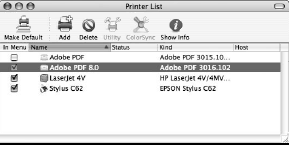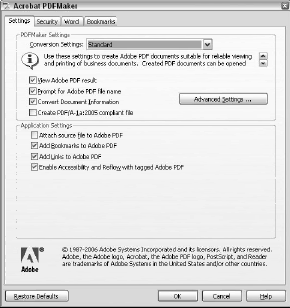PDF Conversion Settings
Windows users have an elaborate set of conversion settings they can address in menu commands when PDFMaker is installed on Windows. Macintosh users may look for the menus I mention, but they won’t find them in OS X.
Conversion settings for Macintosh users are much more limited than their Windows cousins and you need to choose your conversion options, as much as can be done, in the Distiller Adobe PDF settings. When converting to PDF on the Macintosh, the PDFMaker uses a printer driver.
 As your first step in using the PDFMaker, open your Printer Setup Utility and select a PostScript printer. You can also select an Adobe PDF printer.
As your first step in using the PDFMaker, open your Printer Setup Utility and select a PostScript printer. You can also select an Adobe PDF printer.
Click the Make Default icon in the Printer Setup Utility to establish the selected printer as the default.
If you select a desktop color printer or other non-PostScript device you may see unexpected results in the PDFs created with the PDFMaker.
PDFMaker prints Word documents to disk and then converts them through Distiller’s Adobe PDF Settings. However, the Adobe PDF Settings used in Acrobat Distiller are only some of the attributes assigned to the conversion process. You make the other assignments in Word before the file gets to Distiller.
 When you choose Adobe PDF >> Change Conversion Settings, the Acrobat PDFMaker dialog box opens. In the dialog box, four tabs offer attribute choices for how the PDF is ultimately created.
When you choose Adobe PDF >> Change Conversion Settings, the Acrobat PDFMaker dialog box opens. In the dialog box, four tabs offer attribute choices for how the PDF is ultimately created.
The tabs are Settings, Security, Word, and Bookmarks. Different programs support many different features. For example, Microsoft Visio and Autodesk AutoCAD both support layers.
Programs such as Word, Excel, and PowerPoint do not support layers. Excel supports workbooks, Word supports style sheets, and PowerPoint supports media and transitions.
When you open the PDFMaker in any program supporting the tool, you’ll find different conversion settings options.
Be aware that the dialog box you see here changes when opened in other programs. In that Figure, the conversion settings options are specific only to Microsoft Word.
The Settings tab is the first of the four tabs where you select options. At the top of the Settings tab is a pulldown menu for Conversion Settings. From this menu, you choose the settings Distiller uses to convert the file to a PDF.
If you want to edit the settings or create a new Adobe PDF Setting, click the Advanced Settings button to open the Adobe PDF Settings in Acrobat Distiller. The Distiller Adobe PDF Settings enable you to make choices for attributes used to convert the document to a PDF.
Options in the Settings tab are as follows:
- View Adobe PDF result. When the PDF is created, the document opens in Acrobat if this check box is enabled. If it’s disabled, the PDF is created and the Word file remains in view.
- Prompt for Adobe PDF filename. If this check box is enabled, you won’t inadvertently overwrite a file with the same name. Leaving this check box enabled is a good idea.
- Convert Document Information. This option ensures document information created in Word is added to the PDF Document Properties.
- Create PDF/A-1a:2005 Compatible file. Clicking this option automatically changes the Conversion Settings to the PDF/A-1b:2005(RGB) Adobe PDF Setting. The files are made compliant with PDF/A. Note that using PDF/A produces a PDF with Acrobat 5 compatibility; therefore, any features specific to PDF version 1.5 (Acrobat 6 and greater compatible) files are lost in PDF/Acompliant files.
- Attach source file to Adobe PDF. If you want to attach the Word file from which the PDF was created, enable this check box and the Word file is added as a file attachment.
- Add Bookmarks to Adobe PDF. Bookmarks are created from Word style sheets. Select this check box to convert styles and headings to Bookmarks. Make selections for what styles and headings to convert to Bookmarks in the Bookmarks tab.
- Add Links to Adobe PDF. This option ensures that hyperlinks created in Word are converted to links in the PDF document.
- Enable Accessibility and Reflow with tagged Adobe PDF. This option creates document structure tags. Accessibility for the visually challenged and developmentally disabled that are contained in the Word document are preserved in the PDF.
Reflowing text enables the Acrobat user to use the Reflow view. As a matter of default, leave this check box enabled. Tagged PDF documents also help you export the PDF text back out to a word processor with more data integrity than when exporting files without tags.
If you enable accessibility and reflow, the file sizes of your PDF documents are larger compared to files exported to PDF without accessibility and tags. If you need to produce the smallest file sizes for specific purposes where you know accessibility and preserving structure are not needed, disable the check box.
Security
Click the Security tab to open options for security settings. Security options for permissions are available only for High-Bit encryption (128-bit RC4). If you choose to add security from the Word options, the PDF document is compatible with Acrobat 5.0 viewers and greater.
If you need additional security controls available in Acrobat 6 and Acrobat 7 compatibility options, apply the security in Acrobat. Options on the Word tab are as follows:
- Convert displayed comments to notes in Adobe PDF. Notes can be converted to annotation comments that will appear in a text note in the PDF file.
- Convert cross-references and table of contents to links. Any cross-references, such as Table of Contents and indexes, will have links to their respective destinations. These links are preserved in the PDF file.
- Convert footnote and endnote links. Bookmark links are added for all footnotes and endnotes.
- Enable advanced tagging. The tagging features available in Word exports to PDF have been split for accessibility with the Enable Accessibility and Reflow with tagged Adobe PDF files you see in Figure above and this option that adds settings over and above document accessibility.
Checking this box adds document structure for character styles such as underlines, superscript, subscript, outline, strikeouts, and so on that can be useful when exporting PDF files back to text such as exporting to Word or RTF formats.
The downside for selecting this check box is that the PDF conversion will take longer and the file sizes will grow. Unless you anticipate a need for adding this kind of document structure in your converted files, leave the check box unchecked.
- Comments. The lower window lists all comments by author in the file. If you check the box in the Include column, the comments are converted to Acrobat comments. The Notes open column enables you to set the default for note comments with open note pop-up windows.
If you have a document with comments added by several individuals and you want each person’s comments appearing with different note colors, click the icon in the Color column to change color. Keep clicking the icon to continue changing color. Word scrolls through eight different colors as you keep clicking the mouse.
Bookmarks
In the Bookmarks dialog box, there are three items that can determine what Bookmarks will be created in the PDF file:
- Convert Word Headings to Bookmarks. Word headings can be converted to Bookmarks. In the box below the check boxes, a list of all headings and styles contained in the Word document appears. Click the box under the Bookmark column to determine what heads to convert to Bookmarks.
- Convert Word Styles to Bookmarks. You can select user-defined styles for conversion to Bookmarks. Scroll the list of elements and place a check mark for the styles you want to convert.
- Convert Word Bookmarks. Converts all Bookmarks created in Word to PDF Bookmarks.
Click the number appearing in the Levels column and a pop-up menu becomes visible. Click the down pointing arrow to open the menu and select the level of nesting for the bookmarks. The nesting order you determine here in the Adobe PDFMaker settings dialog box determines the order of parent/child relationships in the Acrobat Bookmarks panel when the file is converted to PDF.
If you select the Convert Word Styles to Bookmarks check box and you have a number of style sheets in your Word document, you end up with a huge list of bookmarks. At some point the bookmarks will appear overwhelming and difficult to manage.
Unless you have a definite need for converting styles in some Word documents, stick with the Convert Word Headings to Bookmarks option and convert the heads to Bookmarks. After you select the options in the Acrobat PDFMaker dialog box, click the Convert to PDF tool or select the menu option to convert the file.